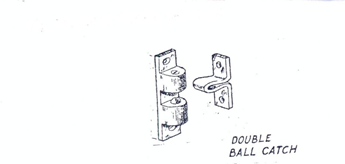Most candidates were able to:
- name the timber defect that occurs when timber is allowed to dry too rapidly;
- name the timber defect that occurs due to improper stacking;
- state the characteristics of oil varnishes.
However, they were unable to:
- state the advantages of casein glue over animal glue.
- sketch a double ball catch.
The expected response to question 3 is as given below:
(a) Advantages of casein glue over animal glue
- casein glue is prepared cold and used cold, thus allowing a longer assembling-time than animal glue;
- casein glue is water resistant;
- assembled job needs not remain in the cramps for tool long as required for animal glue;
- suitable for external use;
- heat can be used to accelerate the drying process of casein glue, whereas heat would remelt animal glue;
- available in various sizes;
- casein glue is fairly water resistant, whereas water would cause animal glue to stain the surface or glue line.
- Timber defects caused by drying too rapidly.
- honeycombing, case hardening, collapse; surface splitting; checks.
Timber defect caused by improper stacking.
- twisting, bowing, cupping, splits, warping, springing.
- Characteristics of oil varnishes
- dries first by evaporation of the solvents and thinners;
- cures or hardens by oxidation of the oils;
- film cures gradually from its outside surface towards the wood;
- slow drying;
- cannot be diluted with water;
- flows smoothly from the brush;
- has high viscosity;
- levels out with less tendency to show brush marks;
- film is tough, flexible and durable.
- Sketch of double ball catch

|



